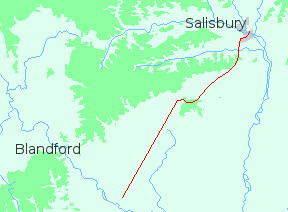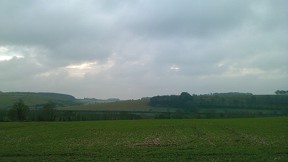
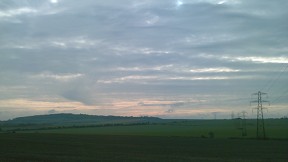
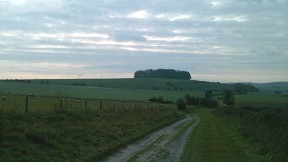
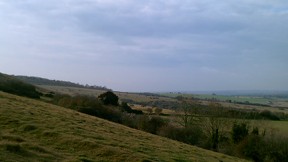
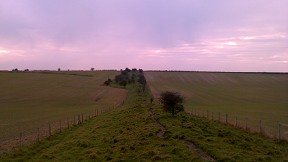
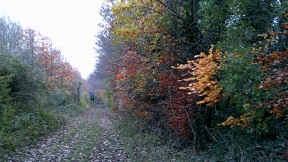
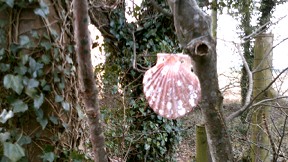
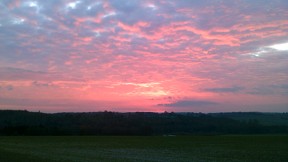
You might think that December is not the best time of year to take a tent for a walk - and you'd be right! In winter, though, you can't be too choosy. You have to make the most of any half-decent conditions. I hadn't done any walking for several months, and a forecast of dry, cold weather was enough for me to pack and set off for Salisbury.
It was certainly cold. They got that bit correct! I set off from the cathedral under a windy sky, and crossing the river ascended Harnham Hill. On the further side I reached the edge of the city.
My plan was to walk across Cranbourne Chase to Badbury Ring and the valley of the Stour. It's an area easy to define but more difficult to describe. To the west of Salisbury are two chalk ridges enclosing the river Ebble. The northernmost ends abruptly at White Sheet Hill; while its neighbour continues to Win Green before bending south in the direction of Blandford Forum. In the angle of this ridge lies a plateau of undulating chalk. This upland is the Chase.
It feels old, far older than Hampshire or the Sussex Downs. In landscape and prehistory it recalls the great necropolis of Wessex, Stonehenge. Barrows litter the landscape. There is a cursus, the longest in England. And there are henges, at Knowlton where a Bronze Age ring embraces the ruin of a Christian church.
Away from the escarpments the land is quite flat. In the deep woods hazel flourishes, seasoned with yew. Out in the open the fields are mostly arable; but near Martin there are downs unfenced and cropped by sheep. Stand there alone on a winters' afternoon as the light is failing and you start to lose your grip on the present. The Chase can be a dark and disconcerting place.
Descending Harnham Hill, I crossed the Ebble and clambered up onto Homington Down. I passed Great Yews, a tract of ancient woodland, then turned onto the old coaching road to Blandford. The tilt of the Chase is south-east and my way lay south-west, so I was crossing the grain of the land; over low, furrowed ridges separating shallow valleys. An expanse of empty downland led me to Martin.
The writer and naturalist W. H. Hudson once stayed here, lodging in a farmhouse near the church. His book, A Shepherd's Life, is a moving account of a lonely downland community. The shepherd, James Lawes (whom he calls Caleb Bawcombe), is buried in the churchyard. A plaque marks his grave.
From the village I found my way through Martin Down nature reserve to Pentridge Hill. Crossing the summit I came upon the bank and ditch of Bockerley Dyke. Like the Wansdyke north of the Vale of Pewsey its purpose is still unknown. For miles it coils over the downs, until finally it disappears beneath the plough.
Beyond the hill I reached the old Roman road from Sarum to Badbury Ring and navigational worries were at an end. My only concern was how far I would get before the light failed. I followed the road, hardly bothering to consult the map as it was generally obvious which way to go.
It was too cold to spend much time admiring the scenery, but at the end of a long tunnel of trees I stopped to eat. As I rested I noticed a scallop shell fixed to a tree. The shell, symbol of St. James, is carried by pilgims travelling on foot to Santiago de Compostella. Why it had been placed there I have no idea; but I took it as a sign of hope, and set out once more in good heart.
Somewhere near More Crichel the light failed. As I walked through darkening fields the sun flamed in a winter sky, then faded. The last five miles were accomplished in darkness, on country lanes and long, straight tracks; until, tired and cold, I passed under the trees clothing the summit of Badbury Ring.
The ground was covered in leaves and low brambles, but I finally got the tent to stay upright. Having eaten, I crawled into my sleeping bag. I was dozing in relative comfort when I was brought to my senses by people talking nearby. Who on earth, I wondered, would be out on a hillfort at night, in the middle of winter?
They appeared to be part of some scout troup, learning how to send messages by torchlight. From the sound of things they weren't very good at it! Communication was mostly achieved by bellowing from rampart to rampart in stentorian tones: "What was that last bit again? WO' DID 'E SAY?" Finally they left and I settled down for the night.

